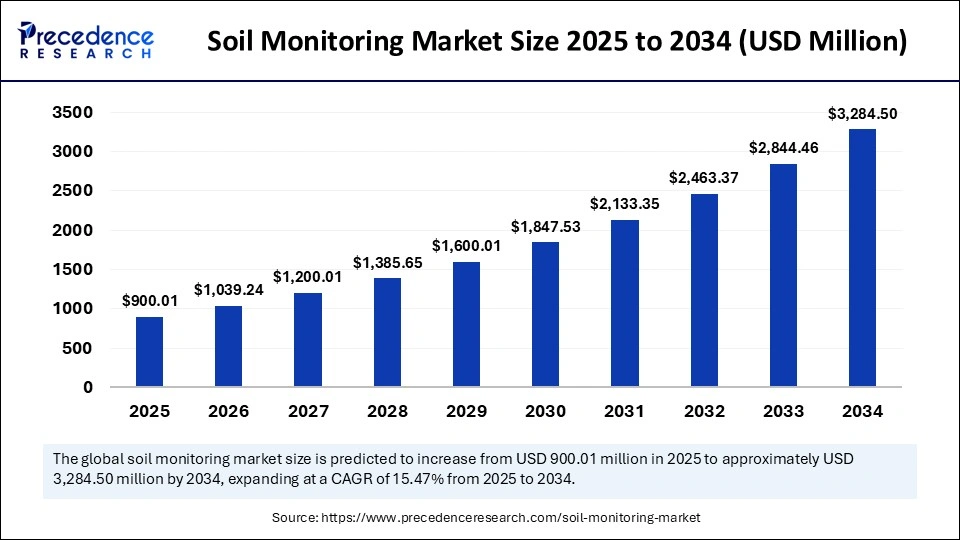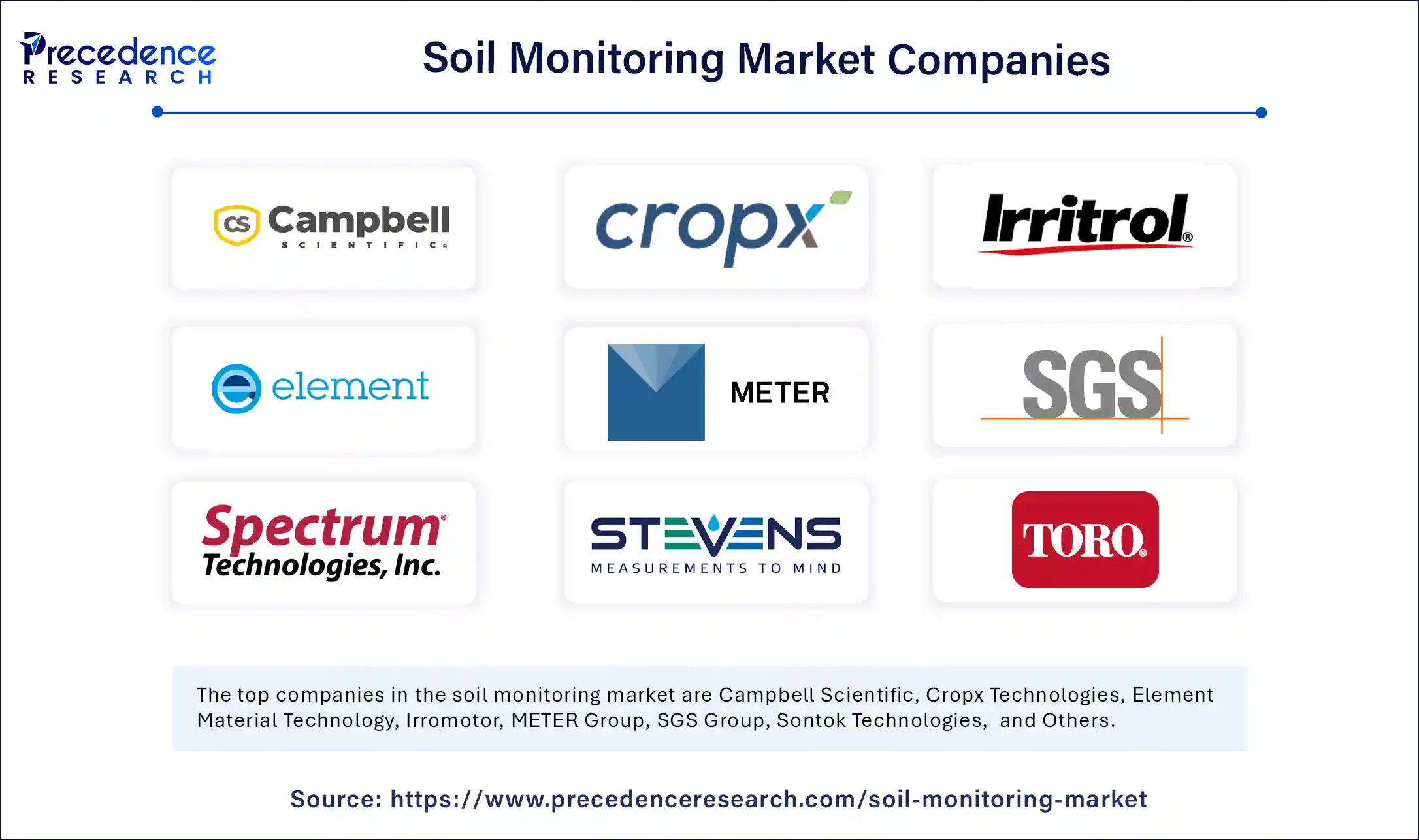
Soil Monitoring Market Key Points
- North America led the global market in 2024, capturing over 37% of the total revenue share.
- Europe is projected to grow at a significant CAGR of 15.5% throughout the forecast period.
- In terms of offering, the hardware segment dominated the market with a 47% revenue share in 2024,
- while the software segment is expected to experience substantial growth in the coming years.
- By type, ground-based sensing emerged as the top segment, contributing 49% of the market revenue in 2024.
- The robotic and telematics segment is forecasted to witness notable expansion over the forecasted period.
- By application, the agricultural sector accounted for the largest market share of 75% in 2024,
- whereas the non-agricultural segment is anticipated to grow significantly in the near future.
Soil Monitoring Market Overview
The soil monitoring market is emerging as a critical enabler of sustainable agriculture and environmental management in the face of rising concerns over food security, land degradation, and climate change. Soil monitoring involves the use of sensors, software platforms, and data analytics tools to assess various soil parameters such as moisture content, temperature, pH, salinity, and nutrient levels. By delivering real-time insights into soil health and behavior, these systems empower farmers, agronomists, researchers, and environmental managers to make informed decisions that enhance productivity, preserve natural resources, and mitigate risks.
The market has witnessed a significant transformation in recent years, driven by the integration of digital agriculture technologies, smart farming practices, and precision agriculture. Soil monitoring is no longer limited to academic or research purposes; it is becoming a commercial necessity in modern farming operations, especially in regions facing water scarcity, erratic weather, or depleted soil fertility. The increasing adoption of wireless sensor networks (WSNs), cloud-based platforms, and mobile apps has made soil monitoring more accessible, scalable, and cost-effective, paving the way for rapid market growth across both developed and developing economies.
Soil Monitoring Market Growth Factors
A key driver of growth in the soil monitoring market is the rising global demand for food production, which puts immense pressure on farmers to improve yields while minimizing resource inputs. This challenge is intensified by the shrinking availability of arable land and declining soil quality due to over-farming, chemical use, and erosion. Soil monitoring helps address this by enabling data-driven irrigation, fertilization, and land management strategies that increase output without harming the environment.
The market is also supported by growing governmental and institutional support for sustainable agriculture, especially in Europe, North America, and parts of Asia. Numerous governments are subsidizing smart farming equipment and digital monitoring tools to promote environmental stewardship and reduce carbon footprints. In parallel, climate change adaptation strategies—including drought mitigation and soil conservation programs—are boosting the demand for continuous and accurate soil monitoring systems.
Furthermore, the proliferation of IoT-enabled smart farming devices, increasing penetration of smartphones among rural populations, and advances in wireless communication infrastructure are fueling adoption. The expanding use of soil monitoring in golf courses, sports turf management, horticulture, and construction further diversifies the market’s scope and growth potential.
Impact of AI on the Soil Monitoring Market
Artificial Intelligence (AI) is revolutionizing the soil monitoring market by adding predictive intelligence, automation, and decision-making capabilities to traditional data collection tools. AI models can analyze vast datasets collected from soil sensors, satellite imagery, and meteorological sources to provide real-time and forecast-based insights for irrigation scheduling, nutrient application, and soil treatment.
AI enhances soil monitoring systems by identifying patterns and anomalies that may not be visible through conventional analytics. For example, AI can predict soil moisture depletion and nutrient leaching trends under various weather scenarios, helping farmers optimize input use and avoid yield loss. Machine learning algorithms are also used to create digital soil maps and classify land types, offering region-specific recommendations and enabling precise land-use planning.
Moreover, AI-powered platforms can automate alerts and actions, such as triggering irrigation systems when soil moisture falls below a certain threshold or recommending crop rotation plans based on historical soil health data. The fusion of AI with drones and autonomous vehicles further amplifies the effectiveness of soil monitoring, allowing rapid, large-scale assessment of soil conditions with minimal human intervention. As AI adoption grows, it will make soil monitoring systems more adaptive, intuitive, and scalable—key factors for accelerating digital transformation in agriculture.
Market Scope
| Report Coverage | Details |
| Market Size by 2034 | USD 3,284.50 Million |
| Market Size in 2025 | USD 900.01 Million |
| Market Size in 2024 | USD 779.43 Million |
| Market Growth Rate from 2025 to 2034 | CAGR of 15.47% |
| Dominating Region | North America |
| Fastest Growing Region | Europe |
| Base Year | 2024 |
| Forecast Period | 2025 to 2034 |
| Segments Covered | Offering, Type, Application and Regions |
| Regions Covered | North America, Europe, Asia-Pacific, Latin America, and Middle East & Africa |
Market Drivers
Several core factors are driving the growth of the soil monitoring market. The most immediate is the need for improved farm productivity and profitability, especially in the face of volatile commodity prices, labor shortages, and climatic uncertainties. Soil monitoring tools help reduce wastage of water and fertilizers, lower input costs, and increase yield consistency—making them highly attractive to farmers aiming to optimize ROI.
Another major driver is the expansion of precision agriculture and smart farming, which depend on real-time field data to guide variable-rate technologies (VRT), crop modeling, and site-specific management. Soil monitoring plays a central role in these ecosystems by acting as a foundational data source. Additionally, environmental regulations and sustainability goals—including efforts to reduce nitrate runoff, conserve groundwater, and sequester carbon in soils—are pushing both public and private sector stakeholders toward technology-driven soil management practices.
The increasing awareness of soil health as a critical component of food security and ecosystem balance is also influencing market momentum. Academic institutions, NGOs, and agritech startups are actively promoting soil monitoring as part of holistic soil fertility and regenerative agriculture programs. The demand for organic farming and residue-free produce further enhances the relevance of accurate soil monitoring systems that help reduce chemical inputs.
Opportunities
The soil monitoring market presents multiple opportunities for expansion and innovation. One of the biggest lies in the integration of soil monitoring with farm management software platforms that aggregate weather data, crop information, and market trends, offering a unified decision-support system for farmers. As interoperability becomes a key requirement, companies that offer open APIs and cross-platform compatibility will gain a competitive edge.
There is also substantial opportunity in developing affordable, user-friendly solutions tailored for smallholder farmers in emerging economies. Solar-powered sensors, mobile-based dashboards, and local language interfaces can significantly expand adoption among underserved rural communities. In addition, the growing focus on soil carbon monitoring as part of carbon trading and regenerative agriculture programs creates a niche segment with strong growth potential.
Urban agriculture, smart greenhouses, and vertical farming systems also represent untapped markets for soil monitoring, particularly where controlled environment agriculture is practiced. Partnerships with research institutions, agri-cooperatives, and NGOs offer additional routes for market penetration. Furthermore, AI-augmented advisory services based on soil monitoring data—such as real-time agronomic recommendations—could evolve into valuable revenue streams through subscription-based models.
Challenges
Despite its promising outlook, the soil monitoring market faces notable challenges. One of the key issues is the high initial cost and complexity of advanced monitoring systems, especially those involving multisensor arrays, wireless networks, and AI-powered analytics. These costs can be prohibitive for small-scale farmers or users in developing regions without access to financing or technical support.
Another barrier is the lack of standardized protocols and data interoperability, which hampers the integration of different sensor types and platforms. This results in fragmented systems and limits the scalability of solutions. In some areas, connectivity constraints and unreliable internet access pose serious challenges to real-time data transmission and cloud-based analytics.
The shortage of technical knowledge and digital literacy among farmers and agricultural workers can also inhibit adoption. Without proper training and support, users may not fully leverage the capabilities of soil monitoring systems, resulting in suboptimal outcomes. Additionally, calibration and maintenance of sensors—especially in harsh outdoor conditions—require ongoing attention and expertise, which can be a deterrent in resource-constrained settings.
Finally, data privacy and ownership concerns may affect uptake in regions where regulatory frameworks are underdeveloped or where farmers are wary of sharing sensitive operational data with third-party vendors.
Regional Outlook
North America leads the global soil monitoring market due to its mature precision agriculture ecosystem, high technological adoption, and supportive policy environment. The U.S. and Canada have well-established commercial farming sectors that prioritize yield optimization, resource efficiency, and environmental compliance all of which drive the demand for soil monitoring technologies.
Europe follows closely, with countries like Germany, the Netherlands, and France heavily investing in sustainable agriculture and digital farming. The European Union’s Green Deal and Common Agricultural Policy (CAP) promote climate-smart practices, further encouraging soil monitoring adoption. The region’s emphasis on organic farming and traceability also supports market growth.
Asia Pacific is witnessing the fastest growth, driven by rapid digitization of agriculture in countries like India, China, Japan, and Australia. Governments are increasingly promoting smart farming practices to address food security challenges and land degradation. The presence of numerous agritech startups and public-private partnerships is also fostering innovation and affordability in the region.
Latin America shows growing interest, particularly in countries like Brazil and Argentina, where large-scale commercial agriculture and increasing export competitiveness demand better soil management. However, infrastructural and economic challenges may temper the pace of adoption.
Middle East & Africa offer emerging potential, especially for water-saving applications in arid regions. Countries such as Israel, the UAE, and South Africa are early adopters, using soil monitoring in conjunction with drip irrigation and desert farming techniques. As awareness grows, soil monitoring may become central to regional strategies for food and water security.
Soil Monitoring Market Companies

- Campbell Scientific
- Cropx Technologies
- Element Material Technology
- Irromotor
- METER Group
- SGS Group
- Sontok Technologies
- Spectrum Technologies
- Stevens Water Monitoring Systems
- The Toro Company
Segments Covered in the Report
By Offering
- Hardware
- Software
- Services
By Type
- Sensing & imagery
- Ground-based sensing
- Robotic & telematics
By Application
- Agricultural
- Non-agricultural
By Region
- North America
- Asia Pacific
- Europe
- Latin America
- Middle East & Africa
Read Also: Soil Remediation Market
Get this report to explore global market size, share, CAGR, and trends, featuring detailed segmental analysis and an insightful competitive landscape overview @ https://www.precedenceresearch.com/sample/6113
You can place an order or ask any questions, please feel free to contact at sales@precedenceresearch.com|+1 804 441 9344